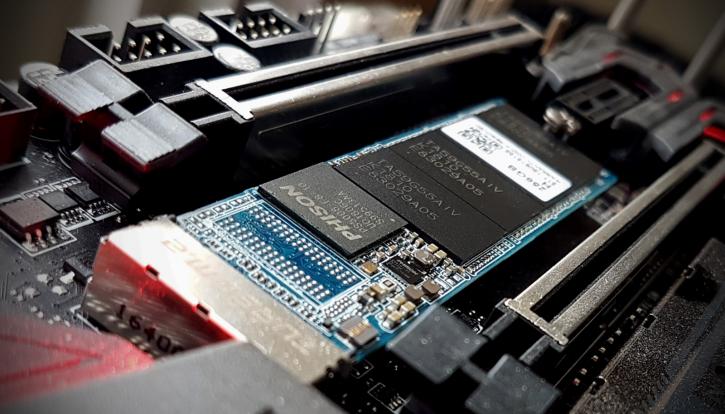Final Words & Conclusion
Final Words & Conclusion
Value for money on the NVMe M2 platform is what the MP32 is all about. It does not disappoint for normal workloads with two to three times the performance compared to and offered normally by a modern SATA3 SSD. That said, the MP32 has one deficit, it does not have a DRAM cache buffer. It solely relies on an SLC written cache. That fact combined with TLC NAND is the recipe for a write performance hole once the caches run out of space. We've seen it, and quite frankly it did not worry me too much. The buffer is roughly 15GB, so you can write sustained or whatever you want to do at the full write speed of 800 MB/sec for 15GB, and after that, you'll see the write performance crumble down to 250 MB/sec. So that fact you'll need to keep in mind. how often do you write such large chunks of data? The read performance is really excellent, and remember this is a value M2 SSD. So if you are on the lookout for something a bit spicier then that SATA3 SSD of yours, but feel that 3000 MB/sec and its accompanying prices are a bit out of your range, then the Mp32 might be a very nice solution.
Also, the people that have occupied it's primary PCIe x3 M2 slot and have only a PCIe Gen 3 x2 lanes available, hey that's where this unit gets a proper chance and can make a lot of sense. The Phison 5008-E8 controller was designed for one purpose, to offer a price competitive solution at PCIe Gen 3 while utilizing just two lanes, pair that with some TLC and added DRAM cache and there you have it. The 256GB SSD as tested costs €79, the 480 GB model sits at €149,- so that's spot on that 30 cents per GB marker and remember, these are NVMe 1.3 and M.2. performance levels, just not that enthusiast class.
Performance wise the MP32 offers what is advertised. It won't kick the 960/970 series proverbial toosh but it certainly is a properly fast device, especially when compared to regular SATA3 SSDs you nearly will have tripled performance (depending on the workload). Remember, to fully utilize the performance that is offered for NVMe you need a supporting infrastructure and this a motherboard with PCI Express Gen3 (x2) interface and NVMe ready BIOS to fully utilize the bandwidth this product needs. NVMe based storage is one the most exciting technologies that we have been following developments closely over the past few years was obviously the development curve of NAND flash-based storage technology. We moved from a "blistering fast" 100 MB/sec towards numbers that are 20 to 30 fold of that. Next to that prices have been coming down, reliability has been top notch and ever so importantly volume sizes have moved upwards to a level where now 500 GB to 1 TB SSDs are getting a norm slowly. The current new mainstream, however, is roughly 480 and 512 GB which offers a nice balance in between performance and value.
Performance
Overall this x2 lane configured unit and pretty much any, any new M.2. storage unit running NVMe 1.3 is fast, really fast even coming from an HDD and lower end SATA3 SSD. The sustained and linear performance is good. For writes, we did notice a TLC write hole (bottleneck) after roughly writing 15GB continuously full speed. The perf dropped to 250MB/sec there. IOPS performance is good on this unit, easily upwards to 250K reads however again sees a perf hit at writes once you stress it for a long time. This SSD writes and reads serious amounts of tiny files in a very fast fashion. We stated it before though, IOPS is not something you as a consumer should worry about too much unless you are doing a lot of database related work or create similar workloads on your PC, but this SSD certainly ranks high within this aspect. Our trace tests also show really good perf, right there in the high-end but not enthusiast class NVMe and that SATA3 SSD. So whether you write lots of small files simultaneously, copy big MKV movies or do it all together, this M.2 NVMe SSD remains a top dog on all fronts, but after 15GB sustained writes performance will fall down.
Concluding
The MP32 definitely deserves the credit of being recommended by Guru3D. The unit does as advertised and gets you a notch or two coming from SATA3 SSD performance. It sits there nicely in the middle and does that really well. All boxes are checked green really, street prices hover at that 30 Cents per GB, the performance which is okay. Teamgroup does only offer 3 years warranty though where many competitors offer 5 years. The MP32 is the kind of device that is easy to drop in and install and could be an excellent secondary M.2. unit if you only have one full PCIe Gen 3 x4 connector available. Why spend more money if your motherboard only offers x2 Lanes PCIe Gen3 right? I mean this is an excellent M2 SSD for storage of your games for example. We all know that Samsung and Micron dominate the NVMe space, so perhaps give some others a chance as well to battle the big guns like Micron and Samsung, that, however, is a difficult task to achieve. The Mp32 is a solid product, it's one deficit is a lack of DRAM caching and thus it solely relies on an SLC buffer. That works great, but after 15GB written the performance hit will be extensive. However, 95% of the time you are reading from a storage unit, and how often do you write more than 15GB continuously? If that is a rare thing (which for most people it is), then this SSD might just be what the doctor ordered value wise, of course.
Recommended Downloads



